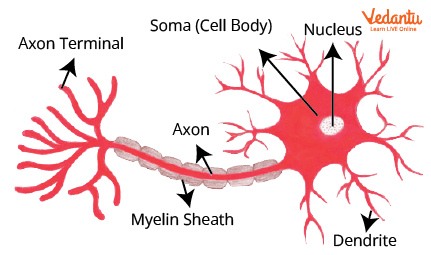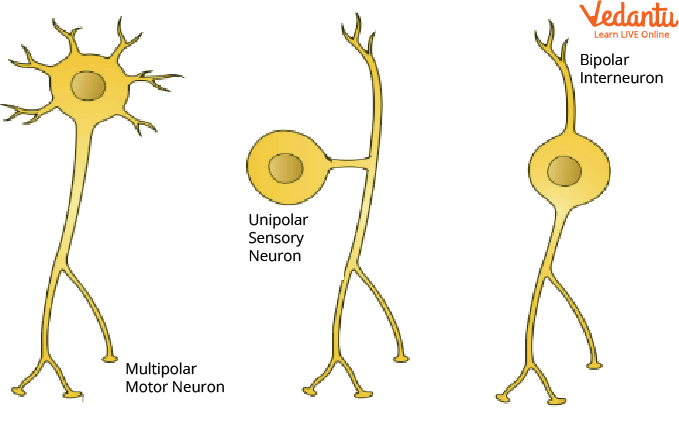




Introduction to Nerve Cell
How well do you recall the location of your body? The truth is that your brain is in charge of your body. It runs the show and manages almost all of your actions, even while you sleep.
Animals use their senses to gather information about their surroundings. The nervous system is a network of nerves and the brain. The nerve cell is a type of cell that sends and receives messages from the body to the brain and back. A weak electrical current transmits the messages. The body's nerves pick up the information. The brain processes the information, instructing it on how to respond.
Nerve cell diagrams are also illustrated below for your better understanding. You can find more information in this article as you read it further.
Parts of a Neuron
The brain is composed of approximately 86 billion nerve cells (also called "neurons"). A neuron is made up of four basic components: Dendrites, the cell body (also known as the "soma"), the axon, and the axon terminal.
Dendrites: Dendrites are neuron cell body extensions that carry information to the cell body. Dendrites typically branch near the cell body.
The Cell Body: The cell body (soma) is the portion of the cell that houses the nucleus.
Axon: A neuron cell body extension that transports information away from the cell body. A single axon emerges from the cell body.
Axon Terminal: Axon terminal is the end of an axon that makes a synaptic connection with another cell. The nerve cell diagram is shown below to understand the neuron parts better.

Nerve Cell
Function of Neurons
Neurons (also known as neurones or nerve cells) are the basic units of the brain and nervous system, responsible for receiving sensory input from the outside world, sending motor commands to our muscles, and transforming and relaying electrical signals at every step in between.
Types of Neurons
There are three types of neurons: Sensory, Motor, and Interneurons.
Sensory Neurons
Sensory neurons send information to the central nervous system from sensory receptors (such as those in the skin, eyes, nose, tongue, and ears).
Motor Neurons
Motor (or efferent) neurons send information toward the muscles or glands from the central nervous system.

Motor Nerve
Interneurons
Interneurons transmit data between sensory and motor neurons. The central nervous system contains the majority of interneurons.

Interneuron
Summary
The brain is in charge of all bodily functions. The spinal cord connects the brain to the back of the body. It is made up of threadlike nerves that connect to every organ and body part. This network of nerves relays messages from the brain to various parts of the body.
Neurons are the cells of the nervous system. They are composed of three distinct parts: a cell body, an axon, and dendrites. These components aid in the transmission and reception of chemical and electrical signals. While there are billions of neurons and thousands of different types of neurons, they can be divided into three functional groups: motor neurons, sensory neurons, and interneurons.
FAQs on Neurons and Its Parts
1. What is a neuron and what are its main parts?
A neuron, or nerve cell, is the basic structural and functional unit of the nervous system, specialised to transmit information through electrical and chemical signals. As per the CBSE Class 10 syllabus for 2025-26, its main parts are:
- Cell Body (Soma): Contains the nucleus and controls the cell's metabolic activities.
- Dendrites: These are branch-like extensions that receive signals from other neurons and transmit them towards the cell body.
- Axon: A long, single projection that carries nerve impulses away from the cell body to other neurons, muscles, or glands.
- Axon Terminal: The end part of an axon that makes synaptic connections with another cell to pass on the signal.
2. What are the main types of neurons based on their function?
Neurons are classified into three primary types based on their function within the nervous system:
- Sensory Neurons: Carry nerve impulses from sensory organs (like skin, eyes) to the central nervous system (brain and spinal cord).
- Motor Neurons: Carry nerve impulses from the central nervous system to effector organs like muscles and glands, causing a response.
- Interneurons (or Relay Neurons): Found within the central nervous system, they connect sensory and motor neurons, playing a crucial role in processing information.
3. How does a neuron's structure help it perform its function?
A neuron's structure is perfectly designed for transmitting signals efficiently. The dendrites act like antennas, collecting a high volume of incoming signals. The cell body integrates this information. The long axon acts as a transmission cable, rapidly conducting the electrical impulse, often over long distances. Finally, the axon terminals convert this electrical signal into a chemical one to communicate with the next cell. This entire structure ensures a fast, one-way flow of information throughout the nervous system.
4. How do different neuron types work together in a reflex action, like touching a hot object?
In a reflex action, all three neuron types work in a rapid sequence called a reflex arc:
- First, sensory neurons in your skin detect the heat and send a high-speed signal to the spinal cord.
- Next, within the spinal cord, an interneuron receives this signal, processes the threat, and immediately passes the instruction to a motor neuron.
- Finally, the motor neuron carries this instruction from the spinal cord to your arm muscles, causing them to contract and pull your hand away. This happens before your brain even has time to consciously feel the pain.
5. Why is the myelin sheath important for a neuron's axon?
The myelin sheath is a fatty insulating layer that covers the axon of many neurons. Its main function is to dramatically increase the speed of nerve impulse transmission. It prevents the electrical signal from leaking out and allows it to jump between gaps in the sheath (called Nodes of Ranvier). This process, known as saltatory conduction, is much faster than conduction along an unmyelinated axon, enabling quick reflexes and complex cognitive functions.
6. What is the difference between a nerve and a neuron?
It's a common point of confusion. A neuron is a single, individual nerve cell. In contrast, a nerve is a macroscopic bundle containing the axons of many neurons, all wrapped together in a protective tissue sheath. To use an analogy, if a neuron is a single copper wire, a nerve is the entire cable containing hundreds of those wires bundled together.
7. What is the longest neuron in the human body?
The longest neuron in the human body is the sciatic nerve cell. Its axon originates in the lower back and extends all the way down to the foot. The axons that make up the sciatic nerve can be over a metre long, responsible for transmitting motor commands to leg muscles and carrying sensory information back to the spinal cord.









